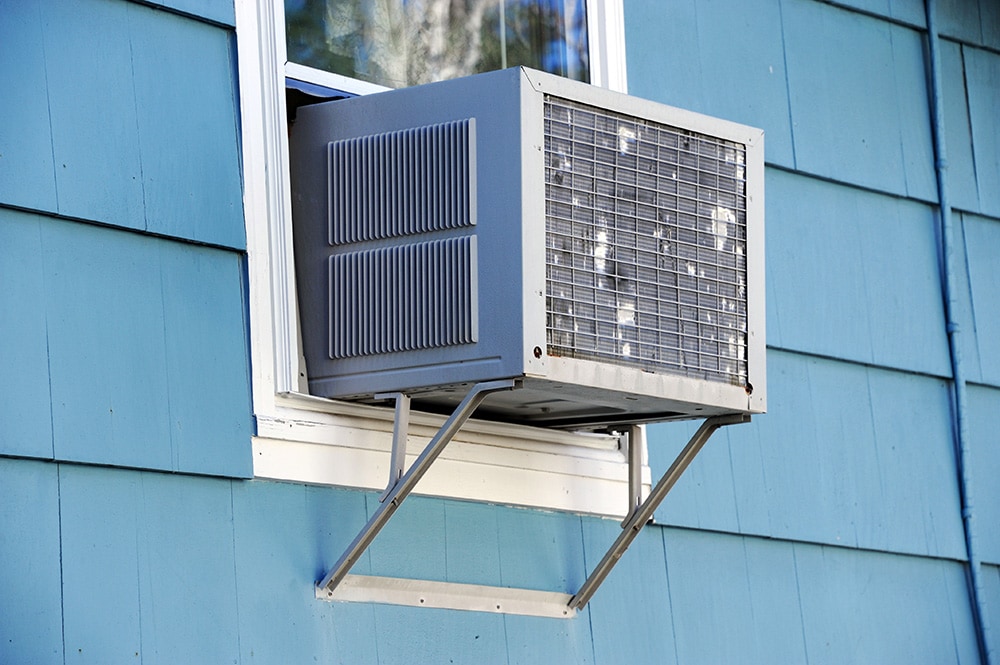How Does a Window Air Conditioner Work? Pros, Cons, & FAQ
-
Pete Ortiz
- Last updated:

Window air conditioners are handy devices that can significantly improve the lifestyle of a homeowner and tenant. They can be installed effortlessly, with minimum experience and knowledge. All you would need to do is find a perfect space for them, a window where they can sit undisturbed and unobstructed.
Read the article below to find out how these unique air conditioners work.
How Does a Window Air Conditioner Work?
Window air conditioners are the simplest AC unit types that work the same way as regular air conditioners. All the working parts and components of a window AC are inside the box, which is mounted to the window. Once plugged into the electrical outlet, this AC removes heat and humidity from the inside air using refrigeration, while the cool air circulates back into the room.
- Thermostat
- Fan and blower
- Compressor
- Condenser coils
- Evaporator coils
- Filter
- Refrigerant tubing
- Expansion valve
Once the window AC is on, the rising room temperature will trigger the thermostat. The AC blower turns on, pulling the room air through the inlet grille. The filter removes dust and particles before the air goes through the refrigeration process. The refrigerant is pumped through the tubing, changing from liquid to gas and again to liquid. As the blower pushes hot air through the coil, the refrigerant begins circulating, absorbing heat and turning it into vapor. This vapor then travels to the compressor, to the condenser coil, and gives heat that’s expelled outside. After this process, the refrigerant goes to the expansion valve and returns to the evaporator coil as a low-pressure, cool liquid.

How to Choose a Window Air Conditioner
You will need to consider many factors before buying a window air conditioner. The size of the home and the window size are crucial properties that you must consider. Since window air conditioners can vary by size and power, it is essential to buy a unit that will work properly and efficiently.
1. The Size of the Window
The size of the window you choose for the air conditioner will be crucial. Since there are many types of windows with sizes that are not standard, you will need to measure the window’s dimensions. Once you have the dimensions, you can choose a matching window air conditioner that will fit perfectly onto your window.
2. Installed or Portable
When installing a window air conditioner, you need to consider whether you will remove it at the end of the season or keep it installed year-round. The only way to determine this is to think about the winters in your specific location and whether they are harsh or mild. Having a window AC installed on the window through the winter can drastically impact the room’s insulation if the winters are harsh—you may want to consider removing it at the end of the season.
Portable air conditioners are excellent if you are looking for an easily maneuverable unit. These units are excellent for moving from room to room, they are easy to assemble, and you don’t have to commit to them. If you are not allowed to install a window or a regular air conditioner, portable air conditioners are a perfect choice.
3. The Square Footage
When picking out the right air conditioner, it is important to consider how well it cools the place. That factor won’t only depend on the quality of the window air conditioner but also the size of the room and the power of the air conditioner. A unit of measurement is used in the United States to describe how effectively a window air conditioner can lower the temperature in a certain room. That unit is called the British thermal unit(Btu). Depending on the size of your room, you must find an appropriate size for the AC.
| Up to 150 square feet: | 5,000 Btu |
| Around 340 square feet: | 8,000 Btu |
| Between 550 and 800: | 12,000 to 14,000 Btu |

Where Is It Used?
The most valuable part about window air conditioners is that their use is various and widespread. There are many rooms and homes where a window air conditioner would be more suitable than other air conditioners.
Advantages of Window Air Conditioners
The advantages of having a window air conditioner in your home or apartment are significant. These units can be more convenient than regular air conditioners and sometimes even more affordable.
- They usually come at a very low, affordable price.
- They are easy to install without the need for a professional.
- No extra space is needed for mounting the window air conditioner.
- They can cool and heat the room throughout the entire year.
- They are easy to uninstall and transfer.
- You can quickly move your window air conditioner from one room to another.
Disadvantages of Window Air Conditioners
While the advantages of installing window ACs are vast, there are downsides that you are required to learn about before making the final decision.
- They block the window and lower the room’s insulation properties.
- They block natural sunlight.
- Window air conditioners are easy to break through if you live on the ground floor.
- Unsuitable for larger homes and spaces.
Frequently Asked Questions (FAQ)
Can I install a window air conditioner by myself?
One of the best things about window ACs is that they are user-friendly, meaning you can install them on your own quickly and flawlessly. Always read the user’s manual and instructions carefully, especially while installing brackets. Once you manage to install brackets on your own, the only thing left is to mount the air conditioner on them.
How do I maintain a window air conditioner?
Proper maintenance of the window AC is one of the most important aspects that can drastically prolong its lifespan. Make sure to clean or replace the air filter frequently, at least once a month. If you have reusable filters, it is advisable to replace them every 2 months.
Vacuum the condenser coils regularly to prevent dirt and debris from clogging. This procedure is simple, and you only need a brush attachment to the vacuum, but it will go a long way in keeping your AC healthy.

A Quick Reference Guide
Power of the window air conditioner and adequate square footage
| Room size in square footage | Window AC power (BTU) |
| 150 square feet | 5,000 BTU |
| 300 square feet | 7,000 BTU |
| 400 square feet | 9,000 BTU |
| 550 square feet | 12,000 BTU |
| 1,000 square feet | 18,000 BTU |
| 1,200 square feet | 21,000 BTU |
| 1,900 square feet | 28,000 BTU |
| 2,700 square feet | 36,000 BTU |
Conclusion
After reading up on window air conditioners, you hopefully have a better insight into how these units work. You will be able to purchase a fitting device in no time, and by using the chart we made above, you will find an appropriate size for any room in your home.
- See also: Best Window Fans – Reviews and Top Picks
Featured Image Credit: ND700, Shutterstock
Contents




